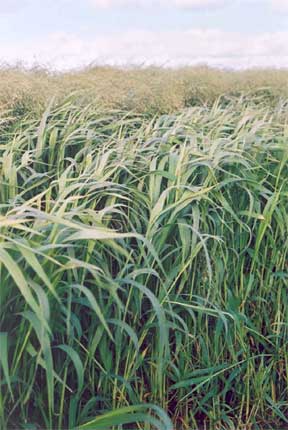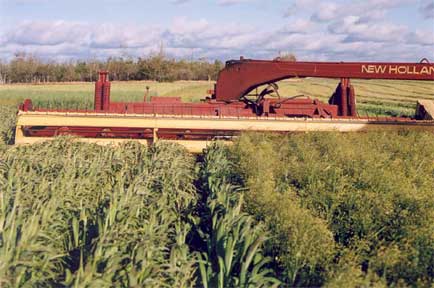| | What is millet?
Millet is an annual warm season grass. There are several different types of millet, but the three most commonly grown in Western Canada are Crown (proso), Siberian (foxtail) and German (foxtail). The foxtail millets are taller, later maturing, and well suited to forage production. Proso millet is usually grown for grain, but can be successfully used as forage. If an earlier seeded crop has failed, proso’s rapid maturity makes it an excellent emergency forage crop. Crown is generally regarded as forage-type proso millet.
Will millet grow in Alberta?
Both types of millet have been successfully grown in Alberta. However, they require a fairly warm climate to produce well. Cooler conditions in west central and northern Alberta can limit the growth potential of this crop. For the best results, select fields that are well drained with a southern exposure. Millet’s warm season metabolism and early maturity allow it to tolerate drought. Proso millet seems to be the most drought tolerant, but its rapid maturity can limit yield potential. Foxtail millet is later maturing and can continue growing into early September, provided there is some rain in July and August. Under severe drought conditions, foxtail millet has been reported to go into dormancy.

German Millet at Hairy Hill, Alberta
September 2003. Photo by Ted Grekul | 
German Millet (on left) Proso Millet (on right)
Hairy Hill, Alberta - September 2003. Photo by Ted Grekul |
| . |  |
What is the best use for millet?
Millet is best suited for swath grazing. Yields and quality tend to be comparable to spring cereals used for the same purpose. However, later seeding dates, warmer temperatures, and drier conditions can favor millet. Millet will resist some weathering in the swath due to a thick waxy coating over its leaves and stems. While this trait is desirable for swath grazing, it makes green feed hard to dry down. Researchers in Saskatchewan have had good success putting millet up as ‘yellow feed’ by pre-harvesting with glyphosate herbicide and then allowing the crop to dry standing. Millet can be made into acceptable silage, but due to the high moisture content (75% at early heading) it will require field wilting before chopping. Foxtail and proso millet are not suited to grazing. The regrowth is poor and the grazing animals can easily pull out the shallow roots. Feeding millet to horses is not recommended, because it can cause excessive urination and kidney irritation.
How should millet be seeded?
Millet should be sown ½ to ¾ of an inch deep. Most sources recommend seeding foxtail millet at 15 to 20 lbs. per acre. Proso millet has larger seeds and higher rates of 20 to 25 lbs. are used when seeding it as a forage crop. Lighter seeding rates have been used, but forage quality and competitiveness tend to be reduced. The higher seeding rates tend to produce shorter plants with finer stems and more leaves. Sow millet into warm soils (about 10 C) when the risk of frost has past.
What about weed control?
Millet is not very competitive until it is about 6-8inches tall. Grassy weed control options are limited and pre-seeding control is the best method. Take advantage of the late seeding date to control the first flush of weeds with tillage or glyphosate herbicide. It may be beneficial to increase seeding rates if weed problems are anticipated. Broadleaf herbicide options may be available depending on the type of weed and growth stage of the crop. Check with your local agricultural retailer for the best options.
What about fertility?
Millet does not have especially high fertility requirements and will produce well with only 30 to 50 lbs of available nitrogen. Higher nitrogen levels will produce considerably higher yields, but severe lodging and the risk of nitrate accumulation in the forage offset any gains.
When should millet be harvested?
Millet should be cut at the boot or early heading stage. Forage quality of German millet harvested at this stage is 10-14% crude protein (CP) and the total digestible nutrients (TDN) are 57-60%. Moisture content is usually 75% at this stage. If silage is intended, wilting the crop to 60 % moisture is required. After heading, foxtail millet will begin to develop sharp bristles in the seed head, which may cause lump jaw and eye irritation. Feed intake is also reduced if millet is allowed to over mature. Proso millet can have excessive seed shatter and become a volunteer weed, when harvested at advanced stages of maturity.
Advantages:
- Well suited for swath grazing. Reported to resist weathering in the swath.
- Good drought tolerance.
- Rapid maturity allows for good yields with later seeding.
- Does not require high levels of fertility to produce adequate yields.
- Forage quality is similar to spring cereals used for swath grazing.
Disadvantages:
- Poor performance under cool wet conditions.
- Sensitive to lodging. Proso millet more so than German millet.
- Not very useful for grazing.
- Not recommended for horses.
- Hard to dry down for green feed production.
- Seeding costs can be high.
- Weed control options are limited.
A special thank you to Wally Vanin of Saskatchewan Agriculture, Food and Rural Revitilization for his knowledge and experience on this subject.
Referenced Links :
Golden German Millet Production in Saskatchewan
Growing Millet in Montana
Prepared by Ag-Info Centre, Alberta Agriculture and Forestry |
|